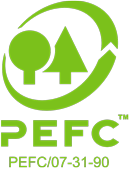Latin name: picea, from the pinaceae family
Spruce fir is still the most common species in Wallonia and in the Belgian Ardennes because it is the one which is the most in its place. When freshly cut, spruce wood is white to slightly pinkish. When exposed to light, it becomes yellowish because of oxidation of the lignite. Placed outside and without protection, it changes to grey.
Spruce fir wood is not durable, its sapwood being listed as having class V durability and its mature wood in class IV[1], which is why it has to be treated to withstand bad weather. Spruce has a low relative density (430 Kg/ m³ at 12% humidity in the Walloon Region) but presents very good static and dynamic bending, axial compression and traction force resistance. Spruce timber has, as a feature, very good straightness, it is very easy to saw and it seasons quickly (with little deformation being recorded when drying).
[1] Source: « Sylviculture et qualité du bois de l’épicéa en Région Wallonne » J Herbert, M Herman and B Jourez, Edited by ASBL Forêts Wallonne




